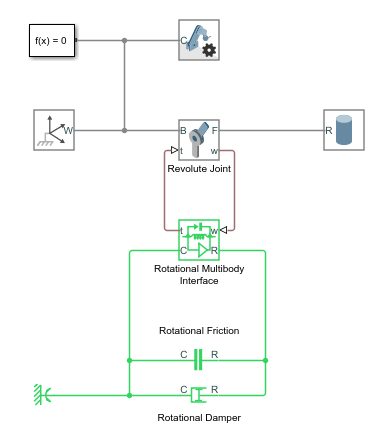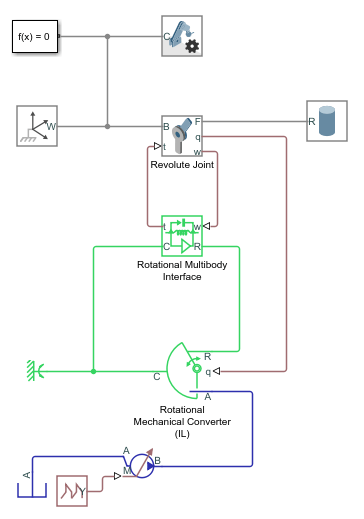Rotational Multibody Interface
Interface between mechanical rotational networks and Simscape Multibody joints
Since R2021a
Libraries:
Simscape /
Foundation Library /
Mechanical /
Multibody Interfaces
Description
The Rotational Multibody Interface block implements an intuitive way to connect Simscape™ blocks that have mechanical rotational ports with Simscape Multibody™ joints that have revolute primitives. Simscape blocks that can be connected to a Rotational Multibody Interface block include:
Blocks from the Foundation > Mechanical > Rotational Elements library, such as Rotational Friction or Rotational Damper.
Blocks with mechanical rotational ports from other Foundation libraries, such as Rotational Mechanical Converter (G) or Rotational Mechanical Converter (IL).
Blocks with mechanical rotational ports from add-on products, such as hydraulic actuators from the Simscape Fluids™ libraries.
The Rotational Multibody Interface block matches the torque and relative angular velocity across the interface. You can connect it to any Simscape Multibody joint that has a revolute primitive:
Enable the velocity sensing port w and the torque actuation port t on the joint. If the joint has multiple degrees of freedom, make sure that the selected velocity sensing and torque actuation correspond to the same degree of freedom.
Connect physical signal ports w and t of the Rotational Multibody Interface block to ports w and t of the Simscape Multibody joint.
Connect ports C and R of the Rotational Multibody Interface block to a Simscape mechanical rotational network.

For detailed step-by-step instructions, see Connecting Simscape Networks to Simscape Multibody Joints.
Blocks like Rotational Friction and Rotational Damper do not require position information, and for these blocks the interface based on torque and relative angular velocity is sufficient. Other blocks, like hydraulic actuators, require information on relative position between their ports. To connect these blocks to a Simscape Multibody joint:
Use the Rotational Multibody Interface block. Enable the velocity sensing port w and the torque actuation port t on the joint, and connect the ports as described above.
Additionally, enable the position sensing port q on the joint. If the joint has multiple degrees of freedom, make sure that the position and velocity sensing and torque actuation all correspond to the same degree of freedom.
On the actuator block, enable the position input port q, by setting the Interface rotation parameter to
Provide input signal from Multibody joint. Connect the position input port q on the actuator block to the position sensing port q of the Simscape Multibody joint.

Assumptions and Limitations
For models with Translational Multibody Interface or Rotational Multibody Interface blocks, it is recommended that you use Simscape Multibody blocks to model masses and inertias. The reason is that Simscape networks need to have a ground (reference) node, with all the masses and inertias in the network accelerating with respect to this node. In a Simscape Multibody joint, both the base and follower frames may be accelerating. Therefore, a mass or inertia in the Simscape network connected to a joint may not have the correct inertial reference.
Examples
Ports
Input
Output
Conserving
Extended Capabilities
Version History
Introduced in R2021a

